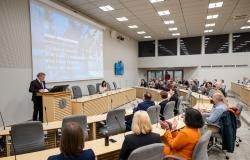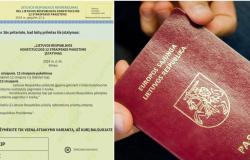Cardiologist at Kaunas Clinics, head of the Kulautuva Rehabilitation Hospital, prof. Raimondas Kubilius stated that a healthy lifestyle is not everything.
“We always emphasize to our patients that no matter how healthy a Lithuanian lives and maintains a healthy lifestyle, at the age of 50 he is already at a high risk of CVD.
And when I think about my environment, the patients, I realize that I have to worry about myself. This is a limit that you may not feel, but the body probably already has to feel it, and we all have to assess it,” he emphasized in the “Zeinia Radio” program “Health Time”.
Do the doctors themselves not forget their health?
Although men have a higher risk of CVD around 50, women around 60, preventive programs for both men and women start at 40.
When asked if he himself, having reached the age of 50, sets an example for patients and checks for CHD, the professor did not hide that this is already the case with doctors, that sometimes they are more attentive to others than to themselves.
“There can be a strong asymmetry – we broadcast how to care, although we are not perfect examples ourselves. Here is a childhood friend recently sent his laboratory tests, where it seems that he has clearly increased cholesterol, he says, I have pain on the left side. I say, you’re young, but when I count his years, he’s really 50 – it’s time to start getting your CVD screening, as well as participating in all the health screening programs offered by the state. (…)
I believe that not all my colleagues are very responsible to themselves. In the same way, I remember being very surprised as a child about the eye doctor working at the polyclinic in my hometown. I thought, he knows everything himself, and he wears glasses. It was difficult to contain my surprise, but now I’m not surprised, because the disease happens, goes on its own way, and we don’t always have the tools and instruments to influence it,” said the doctor.
It can damage the body silently
It is true that the interviewer said that he himself had received a message from the family doctor that he should have a preventive check-up. “I have received calls, I have already registered, I must assess myself to see if I have any hidden but very harmful cardiovascular risk factors,” said R. Kubilius.
“Arterial hypertension and dyslipidemia are called ‘sister killers.’ This means that they can be silent, accumulate in the body and seriously damage our blood vessels”, observed R. Kubilius.
According to him, although he is usually aware of cholesterol levels and blood pressure, his experience in the intensive care unit, where patients who have suffered myocardial infarction are usually admitted, shows that vigilance should never be lost:
“The patients themselves often ask us – I was living a healthy life, I behaved according to the general recommendations, I had only one other risk factor, and here came the most dangerous disease. And you understand that by all means we can judge, but we have to be vigilant and have immunity to risk factors.”
According to the doctor, the biggest pitfall is that many of these diseases are silent at first.
“Arterial hypertension and dyslipidemia are called ‘sister killers.’ This means that they can be silent, accumulate in the body and seriously damage our blood vessels. Maybe we still have myths – we try to protect ourselves from oncological diseases, to find out as early as possible, and we think that cardiovascular diseases will overtake me and I will avoid them”, remarked R. Kubilius.
Headache – new risk factors
When asked if there is a difference in the morbidity and mortality from CVD between people living in the countryside and in the city, the professor stated that the research conducted by him and his colleagues did not show significant differences.
“But when we communicate with my colleagues from my native Gargždas, who mentioned that 2 thirds of them live in the rural area of the district, grow their own fruits and vegetables, and have counted quite a few people who have reached 90, then I had the answer inside that, after all, under such conditions it is easier for a living person to avoid CVD risk factors.
Especially since recently we are talking about new environmental risk factors of civilization, such as particulate pollution, heat, spending summer time in the city, which also affects our vascular system,” he said, adding that assuming that a leisurely, slower pace of life is better for the circulatory system.
In addition, the doctor pointed out that there is more and more talk about the fact that sleeping less than 6 hours or sleep that has lost its circadian rhythm is a new risk factor that directly affects the formation of atherosclerotic plaques.
A heart attack also lays down a young woman
Talking about the current flow of patients in the hospital, the doctor said that about 72 percent consists of 65 years and older patients who already have organic pathology.
“Perhaps this is not surprising, because CVD is a companion of older age and as a co-morbidity. Another contingent is young patients who are more sensitive, even in my practice there were patients who came to the cardiologist’s office every month.
I said that it is not necessary, that service costs money, but he said that he feels more at ease when the doctor evaluates whether everything is fine. Usually, such people work in a responsible job and, apparently, a complex workload, disturbed rest and work regime induces greater stress and anxiety.
“We emphasize that women under 60 have a kind of immunity from CHD due to female hormones. But recently we see that heart attacks also happen to young women. Most of the time, they are all smokers,” the cardiologist observed.
And stress as a risk factor is extremely important for the well-being of the heart and the development of the disease. Maybe the problem is that neither family doctors nor cardiologists have such a tool to assess how much stress a patient is under. Although scientific data show that stress experienced in the family and at work is equivalent to active smoking”, commented R. Kubilius.
True, the doctor regretted that myocardial infarction does not overtake women today. Although CVD is said to kill the most people, the disease has a ten-year delay in women.
“And now let’s emphasize that women under 60 have a kind of immunity from CHD due to the protection of female hormones. But recently we see that heart attacks also happen to young women. Mostly they are all smokers. In women, the atherosclerotic plaque can spontaneously rupture more often, and probably smoking, we can guess, catalyzes this,” observed the cardiologist.
What can we do to avoid circulatory diseases?
When asked what the main advice for a healthy heart would be, R. Kubilius said that there is no consensus on how to behave until the age of 40.
“But everyone over the age of 20 should know their arterial blood pressure and have their cholesterol checked by their family doctor. When I first started working actively 20 years ago, the recommended value for bad cholesterol in patients with myocardial infarction was less than 2.6 nmol/l. Then we accidentally hit the 1.8 nmol/l limit and I thought what a fundamental change it is and how difficult it will be to do.
Finally, three years ago we received new recommendations that the concentration of bad cholesterol should be 1.4 nmol/l. I was naturally shocked, how can it be, after all, we don’t deal with the older indicator, and now, it seems, a new version for 2026, where experts say that the concentration of bad cholesterol should be less than 1 nmol/l.

It seems ominous, but scientists, processing huge data, see that the lower the cholesterol concentration in the blood, the better the patient’s prognosis. But those values are for those who have already been diagnosed with CVD or who have had a heart attack. For healthy people, it should not be higher than 2.3-2.6 nmol/l, depending on what other risks are involved,” R. Kubilius taught.
He emphasized that a very important risk factor is smoking, including electronic cigarettes and heated tobacco. It is also necessary to come up with enough physical activity.
“And we emphasize to the patient – if suddenly there are symptoms in the area of the heart that have never been there before, we say that it is necessary to answer whether it is caused by a heart disease. It should be taken even more seriously if first-degree relatives – father, mother, brothers, sisters – have suffered from CHD.
This must be done up to the age of 40, after which it is necessary to contact a family doctor and participate in the program. If a person is at a low risk, the examination should be repeated after 3 years. The longer we don’t manage the risk factors, we don’t take care, we can have irreparable damage to the blood vessels,” advised the cardiologist.
Especially if acute pain has already appeared, stabbing in the heart area, spreading to the neck, left arm, that is, for the first time in your life, the doctor urged you to urgently consult a doctor.
The majority of Lithuanians die from these diseases: everyone is urged to be careful:
The road to longevity
According to the doctor, the more the public gets involved in screening programs, the easier it will be to treat such a patient if necessary.
“And perhaps we will get rid of the fact that the main cause of death in Lithuania will no longer be cardiovascular disease,” emphasized R. Kubilius.
Although it may seem that it is not so easy to routinely get to a cardiologist in the area, he said that Lithuania is making a lot of efforts to improve the availability of services.

“There is enough information, but there is still a large part of the reserve in the awareness of the society itself, of the citizens, so we should still start with ourselves and have a healthy lifestyle compass within us to navigate. And if it is possible to overcome the main obstacles – to avoid type 2 diabetes, not to get CHD, neurodegenerative disease and oncological disease, then perhaps that great path to longevity opens up”, emphasized the professor.
He agreed that it is really difficult to implement, but it is necessary to try.
“I myself notice that I don’t take the necessary steps, I don’t exercise as much as I need or as much as I recommend to my patients. You really sometimes fall into such a trap – you also want carbohydrates, fattier food.
But somehow you manage to come back. I’m not saying that you need to go to the extreme to follow it, but navigating your imaginary formula for your health seems to me to be necessary today. And the older we get today, the more we step into new decades, the new obligation and duty is even greater for each of us,” stated R. Kubilius in conclusion.
Tags: famous cardiologist message Lithuanians diseases sister killers show symptoms long time
-








